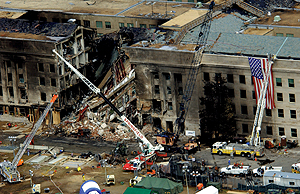A Life in Training
Allyn Kilsheimer had seen the deadly aftermath of the Mexico City earthquake. He’d seen the devastation of the bombing in Oklahoma City. He wasn’t prepared for what he saw Sept. 11. This one was different, he says. “It was in my back yard.”
 Within an hour of the Pentagon plane crash, Kilsheimer’s phone rang for requests from both Washington and New York asking him to aid in the disaster. Within two hours, he was enroute to our nation’s defense headquarters. A structural engineering specialist, Kilsheimer, BS ’63, has become regarded as the go-to guy to call to rescue buildings—and many times, people trapped in buildings—in distress. Within an hour of the Pentagon plane crash, Kilsheimer’s phone rang for requests from both Washington and New York asking him to aid in the disaster. Within two hours, he was enroute to our nation’s defense headquarters. A structural engineering specialist, Kilsheimer, BS ’63, has become regarded as the go-to guy to call to rescue buildings—and many times, people trapped in buildings—in distress.
Within minutes of arriving, Kilsheimer was on scene advising the FBI and Secret Service as to where they could and could not safely go inside the battered building. His work extended into helping other agencies research the crime scene. He and his crew would steer personnel away from potentially dangerous areas. If defense personnel needed something inside the building, Kilsheimer preferred to handle the matter himself.
“There were Navy seals who needed access to some secret places,” he recalls. “We wouldn’t let them do that. We went in and did it for them. I’d rather it be my problem if something goes wrong.”
Kilsheimer traversed the charred corridors of the scarred structure, oftentimes unsure of what he’d find. In fact, “I stepped on the plane’s black box by accident.”
What he saw that day rivaled the worst disaster he had witnessed to date—that of the earthquake aftermath in Mexico City. Of the Pentagon, he says. “You would have to have been there. It was a very difficult place to be.” While Mexico City may have had more lost lives and building devastation, Kilsheimer thinks of the Pentagon as the worst disaster he has ever seen because of its proximity to home. “I live right across the river and that made it a lot worse.”
 With all of his jobs, Kilsheimer seems to have no nervousness about his own safety. His worry comes from the prospect of not being able to help in saving more lives or limiting the damage. So a day like Sept. 11 at the Pentagon was especially distressing. “This time I could not help save lives. You try to find a way to save people. You worry about whether you could have done more to find someone.” With all of his jobs, Kilsheimer seems to have no nervousness about his own safety. His worry comes from the prospect of not being able to help in saving more lives or limiting the damage. So a day like Sept. 11 at the Pentagon was especially distressing. “This time I could not help save lives. You try to find a way to save people. You worry about whether you could have done more to find someone.”
Kilsheimer’s calm, cool, and matter-of-fact manner comes from a humbling upbringing. He grew up poor, he says, walking long stretches of Washington, D.C., because he didn’t have bus fare. And he lost his parents at a young age. “I worked my way through school. But I was fortunate enough to be able to work for a small structural engineering firm when I was young. These people treated me like a son and tried to teach me everything they knew.”
After moving up through the ranks of the business by paying his dues in field work, he started his own company, KCE Structural Engineers, in 1969. When Kilsheimer and KCE aren’t attempting to rescue people and buildings, they design major hotel office buildings, mostly in the Washington, D.C., area.
With a client list that includes the Department of Defense, the FBI, and the Secret Service, it’s no wonder he was called on Sept. 11. Since then, KCE has been responsible for designing and overseeing the Phoenix Project, the official name for the rehabilitation of the Pentagon. It’s a structure they’re familiar with, having worked with a basement addition that was built several years ago. “We have made a commitment that we will have butts in chairs on nine eleven 2002 at 9:38 in the morning,” he says.
Kilsheimer attributes his reputation to his no-holds-barred style. “A lot of people could do what I do but they’re worried about their liability and worried about making decisions by the seat of their pants,” he says. “Usually I can’t get people to do things fast enough—I’m generally kicking people’s asses to get them out of the way.”
And that’s why KCE gets called in emergencies. “They know we’ll get the job done.”
“When you grew up the way I did, having to do the things I’ve done, you’re not scared of anyone except yourself. So I don’t think I get scared during the emergency work. I just don’t understand why I was given the ability to do this work.”
But after Sept. 11, he thinks he understands more clearly now. “It’s as if I’d been in training all my life to do something like the Pentagon.”
—Heather O. Milke
Back to top | Spring 2002 Table of Contents
|